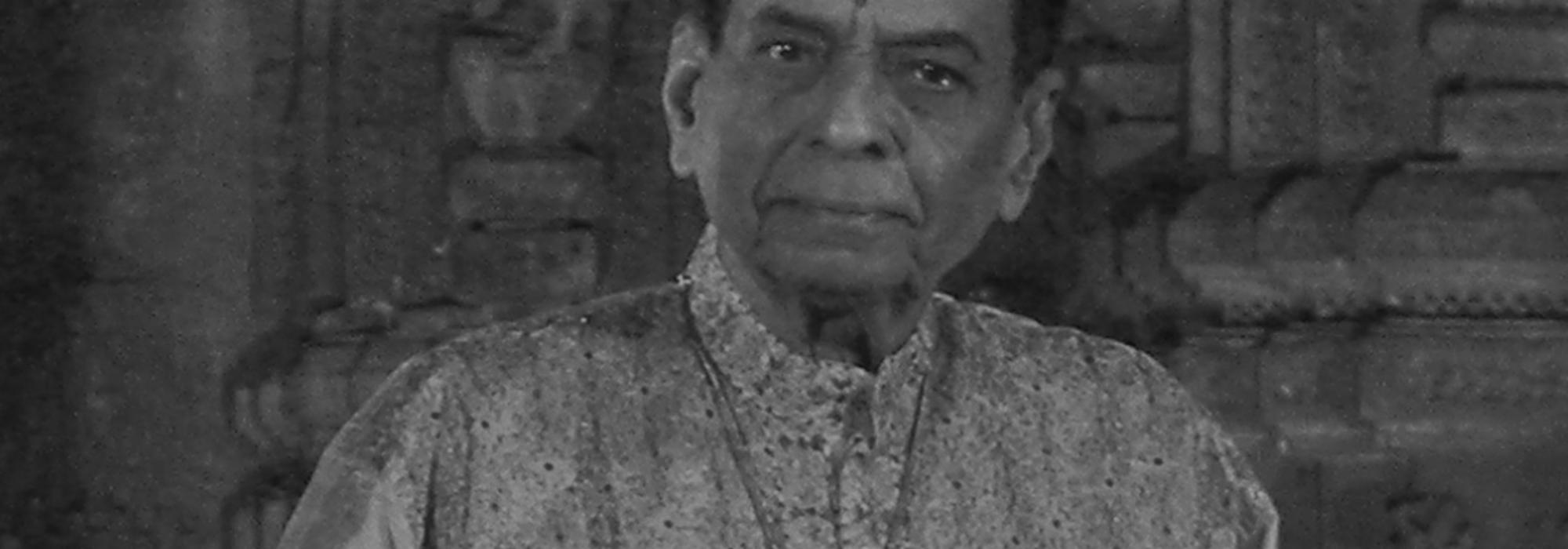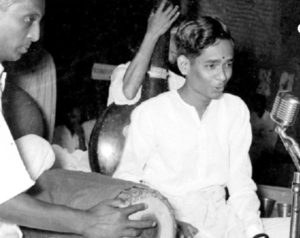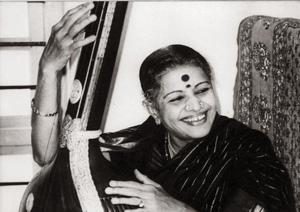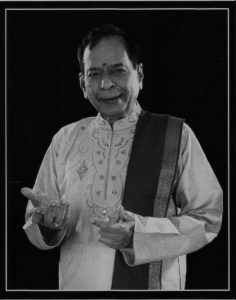About a week ago, Dr. M. Balamuralikrishna passed away.
When we think about his talent and scholarship, cogitate about his achievements and personality, we feel that a legendary saga has passed by. Beyond the specialties and eccentricities of his personality, what attracted the world by the force of its brilliance was his art.
To put it simply, Balamurali made people fall in love with music and cherish it. He is among the few who made Carnatic music accessible to all ears. The hallmark of a great artist is that his art is appreciated by both scholars and laymen alike. If not, at least he produces art that evokes doubt, fear, admiration, and jealousy among the scholars who analyze it. And as for the lay listeners, he makes them consume his art with wonder, joy, love, and concentration. In that sense, Balamurali was an unparalleled musical talent who attracted pundits and laymen, young and old alike with his music.
Balamurali’s greatness lay in his ability to perform a sophisticated and classical form of music like Carnatic music in such a manner that it became simple and easily grasped by the audience. He constructed it merely in the form of music without artificial boundaries. He made South Indian classical music into music, music into song, song into notes, and notes into shruti. He had the unique ability to turn anything into music. Such a thing is only possible for a colossal artistic talent.
I once asked Dr. Padma Subrahmanyam, one such remarkable genius in the field of dance who has transcended boundaries in her chosen field, “In the latter part of the previous century, among the Carnatic musicians, who do you think is the greatest?” Without hesitating a moment, he replied, “Balamuralikrishna.” Perhaps it’s not difficult for one great artiste to recognize another. It so happened that I had the opportunity to quiz Balamurali on who he considered the greatest dancer of our generation. He immediately replied, “Padma Subrahmanyam.” This mutual admiration of greats is a beautiful illustration.
There is a surfeit of information about Balamurali’s achievements, life, awards, and such-like details. That isn’t particularly important to us at this moment. And the question that is often raised – is there a connection between his music and his lifestyle? Is that harmonious or discordant? We could have a huge debate on this matter. But it is a peripheral issue. What is primarily our concern is a careful and methodical study of how Balamurali used his musical training and imagination to create great art and give the listeners a taste of the marvels of music.
Balamurali was a conscious artiste but that is not to say he didn’t have unconscious, inspired talent. However, using his powerful intellect and astute observation, he cognized and cultivated even the intuitive. In that sense, he was a true classical artiste. He left no stone unturned to refine himself, thus becoming a constantly polished gemstone. He perfected his medium of expression and achieved his goals in an ornate manner. In the guru-shishya lineage of Tyagaraja, Balamurali was the fifth generation but it was he who gave a new life to Tyagaraja’s kritis. He didn’t sing the Tyagaraja kritis the way they had been sung till then. Of course, he would claim that his was the pure tradition. Whether or not it was a pure tradition or an impure one, let us place that analysis aside for a moment. Is that music evoking joy, is it beautiful, and is it perfectly in pitch – when we take these into consideration, we will understand the ultimate meaning of what pure tradition should be. So often in art, beyond what is pure or impure, what is right or wrong, what becomes of paramount importance is what is joyful and what is not, what brings comfort and what does not. In this background, Balamurali was a musician who was able to evoke a sense of joy and comfort while singing the kritis of Tyagaraja and other composers. Whenever Balamurali sang a kriti, he would not only highlight the uniqueness of the composer but also add his own signature touch to it.
Unfortunately, the greatness ended with Balamurali, as he couldn't pass that on to his disciples. A few musicians who have come forward today, having learnt music from Balamurali have not come forward in the art; they have ended up staying behind him – not in his light but rather in his shadow. They ended up becoming pale and shadowy imitations of Balamurali rather than coming up as a forceful and bright musical talent. While Balamurali did not specifically cultivate a bunch of disciples, almost every musician who came after him, was deeply influenced – positively or negatively – by his brilliance. The future generations of musicians had to either agree with him or disagree with him, but could never ignore him. In this context, I am reminded of Adi Shankara and his contribution to Vedanta. Every single philosopher/thinker who came after Shankara had to either align with his philosophy or vehemently oppose him – it was impossible to ignore him. This is perhaps a common factor with path-breaking geniuses.
Balamurali sang the songs of several composers. In the case of those songs where the lyrics were available but not the original tune, he set tunes to the lyrics and sang them; be it the songs of Annamacharya or Bhadrachala Ramadas. He gave a unique flavor to the melodies he created for the lyrics of Svati Tirunal and the ashtapadis of Jayadeva, touching the hearts of the listeners. In every aspect of music, he left his unique mark. When we compare him as a composer with a musician who was far more renowned and had attained the status of a saint, Smt. M S Subbulakshmi, we find that she hardly showed the world her abilities in composition. We find Balamurali to be a far greater musical brain when compared to MS. This is not to belittle MS’s music or her immense contribution to music. When we compare two musicians or engage in a critical analysis of an artiste, it is never to put down their achievements but rather to establish the degrees of excellence in that field of art and to confirm our own values and understanding.
Balamurali, by his own admission, took to music at a very young age and without any effort. He went a step further and proclaimed on many occasions, “Music came to me. I didn’t learn music." "Music sings through me." "I don’t know any music. But music knows me very well.” He felt that he was a medium for music rather than music being a medium for him. It is also true that Balamurali was a clever person. As much as he was a visionary, he was equally shrewd. More than humility, what he had was pride and a sense of ego. However, since he was a brilliant artiste, even the arrogance became an ornament for him. Of course, the simplicity of an unadorned one is far more enchanting. In this context when we see M S Subbulakshmi, she was at the pinnacle of such unadorned simplicity and humility. In that sense, what Ananda Coomaraswamy said of art – that it is ‘divinely enshrined’ – becomes true and more meaningful. And that is rasa. A vision of the form of the true Self is rasa. In this vision, there is only wonder and no conceit. Free of ego or arrogance, free from possession or exclusion, one reaches an unassailable position. On occasion Balamurali reaches that pinnacle. At other times, he doesn’t. One is reminded of D V Gundappa’s verse from the Kagga – “…how to teach art? One may teach a thousand rules and tricks but without innate skill, one can’t succeed. All that is within you, Mankutimma!” Merely with talent, scholarship, and proficiency, one cannot become a great artiste – it calls for something more. This is not to demean the fantastic talents of Balamurali. His achievements are matchless.
Balamurali learnt only a limited amount from his guru; his talent was enormous. Perhaps he didn’t practice all that much. But to go with that talent, there must have been a modicum of rigorous practice and a great deal of thinking and study; this we mustn’t forget. Even a great tree was a tiny seed at one point, but to accept that was perhaps injurious to the ego. In rare and miraculous instances a great tree could be created as it is. A jivanmukta from birth, like Shankara, shared the path to mukti for the welfare of the world. Similarly, it isn’t too difficult for a great artiste to either grasp intellectually or guess intuitively the equipment needed for great art, which will be useful for capable artistes and students of art. Balamurali didn’t bother to do this and it is the society that lost out in the process. What remained was a fascination with his music and the possibility to tread his path was lost. For the continuity of the tradition, if he had demonstrated the path that he took, it would have been greatly valuable and beneficial for those few who might have had the courage to tread it. This is what our tradition also has held. Among our ancient writers of shastras—irrespective of their personal capacity—none have had any contempt for this codification of practice methodology. Herein lies the trait of any system of knowledge. If he had taken the extra step to demystify his art, it would have taken on greater meaning. For connoisseurs of arts like us, it would have had great value. However, it would be unfair to feel disappointed for what we don’t have and ignore what we do have. DVG writes, “What kind of manure is needed for what kind of flower?” – in other words, who knows what goes into the making of an individual! If Balamurali had gone towards the systematic exposition of his mental process, would his art itself have suffered; we don’t know. That is also a solace. Again, to quote DVG, “It is a solace but a joyless solace.” Indeed it is our great fortune that this joylessness is no match for the peace and happiness he gave us with his music.
Balamurali sang many famous kritis and well-known ragas but he always brought newness into them; that was his exceptional musical skill. He could take something so familiar and convert it into something totally alien, but that wouldn’t alienate the audience; the unfamiliarity would bring wonder and joy. It is but natural to have complacence towards something familiar; Balamurali would destroy that complacence in the listeners, giving a fresh birth to the seemingly banal kritis or ragas. Even his harshest critic will have to but admit that he showed a hitherto unknown facet of the kriti or the raga, thus adding to the possibilities of kriti/raga exploration. One is bound to agree that his path is one of essence and freshness. It is important to recognize this. He rendered unknown, unborn, and unthinkable ragas – including those with three notes or four notes, which traditional musicologists called svarantara and had discarded as having no aesthetic potential – with charm and aesthetic relish. Isn’t raga, by definition, something that charms us? What could be a greater testimony than that we experienced rasa? People fell in love with his music – it didn’t matter how many notes he sang. By making the unfamiliar accessible and the familiar wonderful, he built eternal golden bridges between the notes and the ears. In my opinion, this was his greatest achievement.
He created new ragas, new talas, and new compositions, a good portion of them standing the test of time as can be observed from the choices of the rasikas. His compositions in well-known ragas and the ragas of his own creation have enthralled listeners for years. His compositions have been used not only in Carnatic music, but also in the fields of semi-classical music, light music, film music, and functional music. But on occasion, what he created with great gusto didn’t cut it with the listeners. A prime example is his creation of new talas like Trimukhi, Panchamukhi, and Saptamukhi. It wouldn’t be inappropriate to mention here his illusions about music therapy and imprudent claims. We should perhaps ignore this as the idiosyncrasy of a great artiste. Often, the exposition of talas is built on an artificial foundation; a rhythmic cycle that can’t be naturally recognized by the ear doesn’t have aesthetic value, merely a theoretical one. Therefore, those rhythmic structures don’t stand the test of time. And nobody needs to feel bad about it. On the other hand, what Balamurali achieved with melody is unparalleled. For that matter, all of Indian music is largely dependent on raga as opposed to tala. There can be raga without tala but rhythm without melody can’t stand on its own for too long. Since this is evident to us, we find great value in Balamurali’s melodic brilliance that gave joy to millions. Having said that, his rhythmic brilliance was such that it brought comfort to listeners – indeed without emphasizing the rhythm, he sang by subordinating it to melody, something that not too many have been able to do.
Balamurali’s career traversed all aspects of music – as a singer, composer, instrumentalist of string and percussion instruments; in the fields of classical music, light music, film music, and other forms. In his jugalbandhis with North Indian classical musicians, he stood on his own often outperforming his fellow artistes. Generally, North Indian classical musicians have a condescending view of South Indian classical music, even going to the extent of altogether ignoring this traditional form. They often ask – what kind of pitch perfection do these South Indian musicians have? Does their music bring comfort? Can they sing an elaborate raga alapana? It is immaterial here whether these questions are honest or not. South Indian classical musicians have their own reservations and criticisms of their North Indian counterparts – their music is not lyrical, they are weak in tala, they don’t follow a fixed rhythm, etc. There is no need to wrangle, for such assaults are at the root of ignorance and it is plain foolishness to find reasons for ignorance. One thing can be said however: the North Indian classical musicians had undiluted regard for Balamurali. The reason was simple; whatever they could do, he could do but what he could do, they could not always do. Balamurali never saw music caged within a specific genre or traditional framework; instead he viewed it simply as music at the level of sound that leads to perfect silence within. Not merely contended at having this ability, he also proudly spoke about it and proved it to the world. Many people who have the capacity don’t have this trait of self-praise and confidence. Balamurali can be likened to poets like Sriharsha, Panditaraja Jagannatha, and Srinatha. They ensured that their own ego or identity was never lowered in any manner. This is perhaps both a virtue and a vice. When an emotion touches the pinnacle of rasa, it becomes respectable. In this sense, his self-confidence and scholarship shone on the stage but what he did off stage became more of a warning than an inspiration.
The care that Balamurali took to make people around him comfortable was one of his attractive qualities – be it his accompanists or the rasika s who went to meet him before or after a concert, he always put them at ease with his humour. At the same time, he also suggested by his gestures and smiles, as if to say, “I’m better than you. But you already know it.” This pride was, however, free from malice. He had great affection for the audience. If a rasika got pained by Balamurali’s behavior or by his self-laudatory humor, it is probably due to jealousy more than anything else. People who love his music wouldn’t have a problem with it.
Even as a teenager, he composed kritis in all the melakarta ragas. When asked about it, he said, “It happened by itself, not by an attempt.” But the truth is that behind his compositions lie a great deal of work and attempt; but perhaps he never observed it as he was so involved with it. Ever so often, when we are engrossed in doing something we love, it doesn’t come across as hard work. We might have labored for it but what remains in our memory is only the joy. Perhaps it is in this backdrop that Balamurali said, “They came to me of their own.” Like Kalidasa says, “इष्टे वस्तुन्युपचितरसाः प्रेमराशीभवन्ति,” the toil that is aligned to our inner nature brings only comfort and becomes a part of rasa. We understand this in the case of artistes who find joy not only in creating music but also in practicing music. Balamurali must have worked hard for perfection of both lyric and song. And even there, it becomes clear that he worked harder in the case of the lyrics, for literary ability doesn’t come without study. While one might have imagination, it isn’t easy to express it in a beautiful form automatically. For excellence in expression, one has to work hard. Balamurali has on many occasions referred to himself as a poet. His poetic abilities were at the level of a good singer-poet but not above that. The great scholar and musician Rallapalli Ananthakrishna Sharma says while critically analyzing Tyagaraja, “We respect Tyagaraja because of his music, not because of his bhakti or his lyrics; his bhakti is beyond our reach and his lyrics are not sufficient for us.” I have no clue if Balamurali had bhakti or not. He definitely had good knowledge of literature and poetry. But for those of us who have had the opportunity to enjoy the great works of literature in Kannada, Sanskrit, and Telugu, the lyrics of his kritis are not something remarkable. It is true that the command that Balamurali had over music and lyric is unequalled among his contemporaries. In that regard, in the guru-shishya tradition of Tyagaraja, he is the next person who had such a command over song and verse, of course besides being a great singer.
To be concluded...
Translated from the original Kannada.

















































Comments